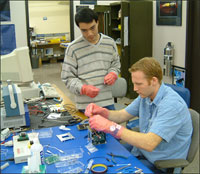Canadian Advanced Nanospace eXperiment Program
CanX (Canadian Advanced Nano Space eXperiment ) is a satellite series of the Institute for Aerospace Studies at the University of Toronto, Canada. It should cost micro- satellites and satellite technology are researched, designed and built to achieve the comparable performance to conventional, bulky satellite. The form factor of these satellites is based on the CubeSat format. They consist of modern technology and subsystems such as high-performance on-board computers, micro control sensors and high-speed data connections.
CanX 1
The first satellite was CanX CanX -1. It was a research satellite with which it explored the foundations for the later following satellite. At the primary mission included the exploration of nanotechnology in space, especially the influence of space on the nano-satellites as a whole, and the individual board systems. A camera with CMOS sensors, a small on-board computer, as well as three active magnetic bearing stabilizers were on board. The satellite was successfully launched on 30 June 2003.
CanX 2
The satellite CanX 2 was the predecessor CanX 1 in performance far superior. The satellite mission was two-fold. The first mission objective was to demonstrate that smaller satellite achieve comparable performance to conventional satellites, however, are much larger and more expensive. Moreover, newer systems for subsequent satellite CanX 4 and 5 should be explored. The second mission objective was to generate scientific data. The satellite was launched on 28 April 2008 together with CanX 6.
CanX 3
The planned satellite CanX -3 ( also known as BRITE ) is part of the comprehensive six nano-satellites BRITE Constellation and a joint project between Austria, Poland and Canada. He is considered a follow-up project for the Canadian space telescope MOST. With this network of space telescopes will be explored in the biggest and brightest stars. The satellites include a differentiating photometry. With this system, the Starlights are explored on the structure and composition and other areas. The satellites come with a 3 cm large optical telescope.
CanX 4 and 5 CanX
The satellite CanX 4 and 5 CanX be brought together into Earth orbit. The aim of the mission is to demonstrate that two satellites flying in precise formation automatically, without requiring a technician or the ground control intervention. The launch is scheduled for the first quarter of 2014. [ Deprecated]
CanX 6
CanX -6 is also known under the name Nano Satellite Tracking of Ships (NTS). The satellite was launched on 28 April 2008 together with CanX -2 and was mainly used for automatic identification and observations of cargo ships from space.









